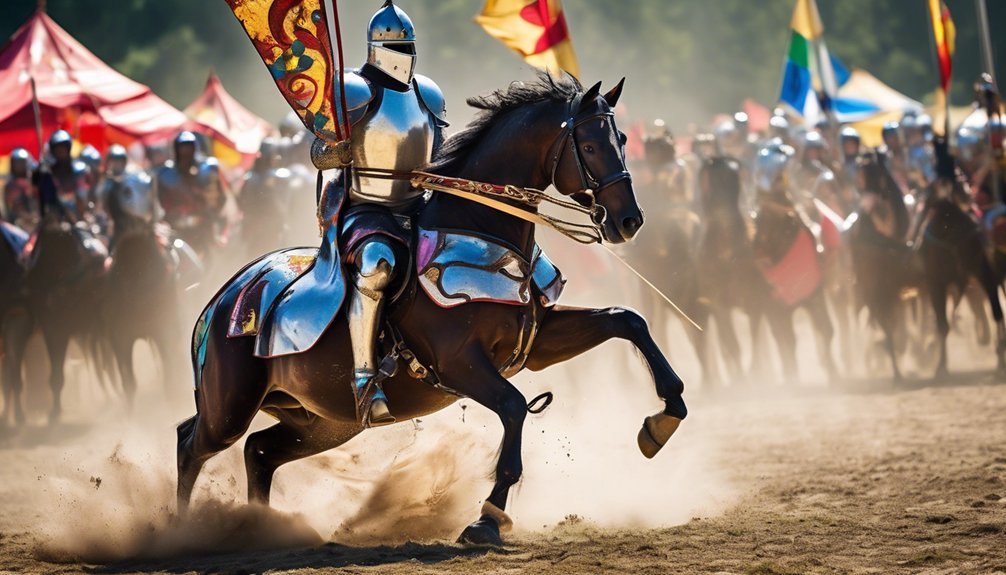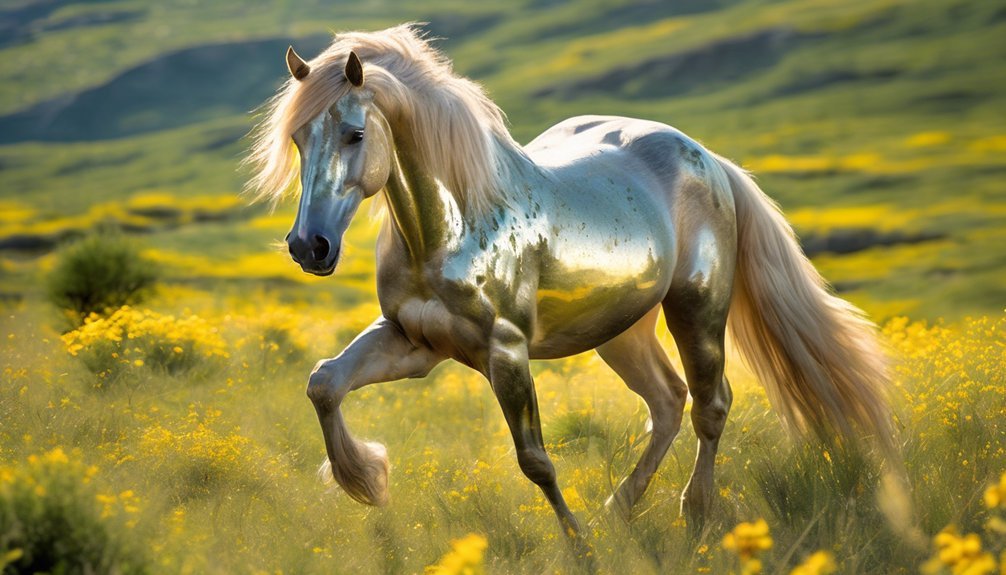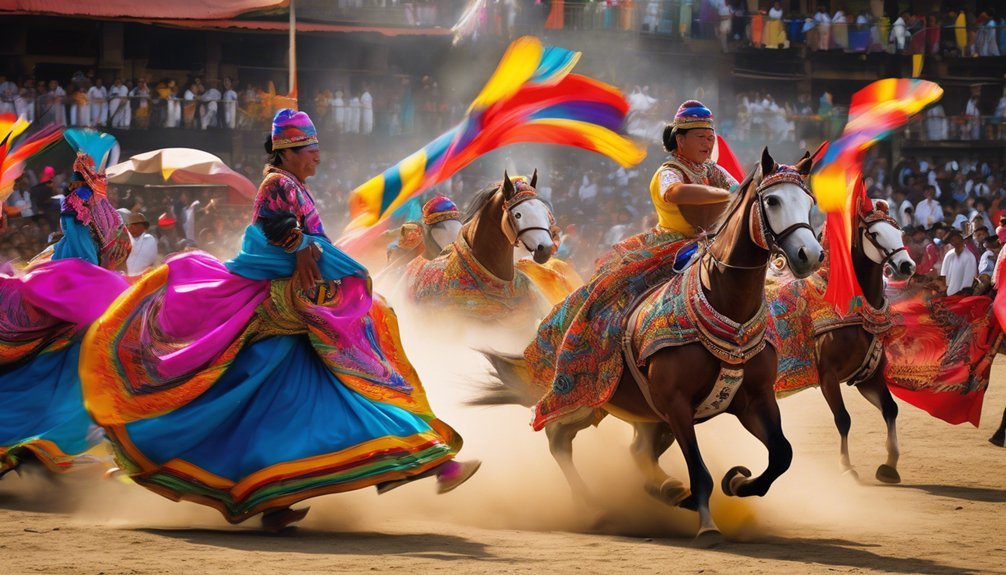
In medieval jousting, horses weren't just mounts; they were the very backbone of a knight's prowess. Their selection demanded careful consideration, as the right horse could mean the difference between victory and defeat. The bond between knight and destrier was critical, influencing performance in the arena. As you explore this dynamic relationship, you'll uncover how these majestic animals shaped the art of jousting and the very spirit of knighthood itself.
Key Takeaways
- Horses, especially destriers, were vital in jousting, providing strength, stamina, and stability for knights during competitions.
- A strong bond between knight and horse enhanced communication, trust, and overall performance in the jousting arena.
- Proper training, including desensitization and agility exercises, prepared horses to respond effectively in high-pressure situations.
- Horse armor, such as plate and chainmail, protected steeds while allowing for mobility, crucial for jousting success.
- Jousting horses exemplified athleticism, precision, and grace, contributing significantly to a knight's effectiveness and strategy in tournaments.
The Importance of Horse Selection in Jousting

When it comes to jousting, the selection of a horse isn't just important—it can make or break a competitor's success. The right horse enhances your jousting techniques, allowing for precision and agility during a match.
A well-matched steed provides the stability needed to absorb impacts and maneuver quickly, critical in the heat of competition. Equally essential is horse care; a healthy, well-trained horse responds better to your commands and maintains stamina throughout the event.
You'll want to consider temperament as well, as a calm horse can significantly reduce anxiety, enabling you to focus on your strategy. Ultimately, a horse isn't merely a tool; it's a partner in your jousting journey, deserving of diligent attention and respect.
Types of Horses Used in Jousting
When you consider the types of horses used in jousting, it's essential to understand the specific characteristics of war horses.
These powerful animals, often bred for strength and stamina, played a crucial role in the success of a knight during tournaments.
Examining various breeds reveals how their unique traits contributed to the effectiveness and safety of jousting events.
War Horses Characteristics
Jousting, a quintessential spectacle of medieval chivalry, relied heavily on the unique characteristics of war horses, known as destriers.
These magnificent creatures weren't just mounts; they were vital partners in the arena, exhibiting specific traits essential for success.
To truly appreciate their role, consider these key characteristics:
- War Horse Temperament: A calm, focused demeanor helped them endure the chaos of battle and competition.
- Jousting Stamina: Their physical endurance enabled them to sustain high energy levels throughout multiple rounds.
- Strength and Power: A robust build allowed them to withstand the impact of collisions.
- Agility: Quick reflexes were crucial for navigating the challenges of the jousting field.
These traits made destriers indispensable to knights, enhancing the thrill of medieval jousting.
Breeds for Jousting
The choice of horse breed played a significant role in the effectiveness of jousting competitions. You'd find that the ideal jousting breeds, such as the destrier, were prized for their strength, agility, and temperament.
These majestic horses, often descended from distinguished horse lineage, could charge forward with remarkable power while remaining composed under pressure. A well-bred destrier could withstand the impact of a lance, making it invaluable in contests.
In contrast, lighter breeds like the courser provided speed and maneuverability, enabling quick turns and tactical advantages.
Understanding these distinctions helps you appreciate how the right horse could enhance a knight's performance, intertwining their fates in the arena of honor and valor.
Training Horses for the Joust
While many might assume that a knight's prowess in the joust solely hinges on their skill with a lance, the success of any jouster fundamentally relies on the training and temperament of their horse.
Effective training methods help horses respond swiftly to the jousting techniques required in the arena.
Here are four essential components of training horses for the joust:
- Desensitization: Expose the horse to loud noises and sudden movements to reduce fear.
- Lance Familiarization: Introduce the horse to the lance gradually, ensuring comfort with its presence.
- Agility Training: Enhance the horse's ability to maneuver quickly and gracefully.
- Bonding Exercises: Foster trust between horse and rider, crucial for effective communication during the joust.
These elements ensure that the horse isn't just a participant, but a vital partner in the jousting experience.
The Relationship Between Knight and Horse
A strong bond between knight and horse can be the deciding factor in the outcome of a joust. This relationship isn't merely functional; it's a profound partnership grounded in mutual respect and understanding.
Through bonding rituals—like grooming, feeding, and gentle riding—knights foster trust building with their steeds. These rituals serve as a foundation for communication, allowing the knight to sense their horse's moods and needs, and vice versa.
When you witness a knight and horse move in perfect harmony, it's a testament to this intricate bond. Trust is everything in the heat of competition; a horse that feels secure under its rider can perform with unparalleled courage and agility.
Ultimately, this symbiotic relationship is essential for success in the arena.
The Role of Equipment and Armor for Horses

When considering the role of equipment and armor for horses in medieval jousting, you'll find that the types of horse armor significantly impacted both performance and protection.
Understanding jousting equipment essentials not only enhances your appreciation of the sport but also highlights the intricate relationship between a knight and their steed.
Each piece of armor served a distinct purpose, shaping the dynamics of competition and horse safety.
Types of Horse Armor
Horse armor, or barding, played a crucial role in medieval jousting, significantly impacting both the horse's protection and performance in the heat of competition.
Understanding the different horse armor types can enhance your appreciation of historical armor designs and their function.
- Plate Armor: Crafted from metal plates, it offered maximum protection against blows.
- Chainmail: This flexible armor allowed for mobility while still safeguarding against cuts.
- Leather Barding: Lightweight and easier to maneuver, it provided basic protection without sacrificing speed.
- Decorative Barding: Often embellished, it served both protective and aesthetic purposes, showcasing the knight's status.
Each type reflects the evolving needs of jousting, blending artistry with functionality, ensuring the horse remained a formidable participant in the tournament arena.
Jousting Equipment Essentials
While the knight's armor often garners the most attention in jousting, the equipment and armor designed specifically for horses are equally vital for success in the tournament. Horses require specialized protective gear to endure the intense impact of jousting lances, ensuring both their safety and performance.
| Equipment | Purpose | Importance |
|---|---|---|
| Horse Armor | Protects vital areas | Reduces injury during collisions |
| Jousting Lances | Primary offensive weapon | Determines match outcomes |
| Breastplates | Shields the chest | Supports mobility and protection |
| Leg Guards | Protects legs from strikes | Maintains horse's agility |
The right combination of equipment not only enhances your horse's endurance but also contributes to a successful jousting experience. Prioritizing their gear ensures a formidable presence in the arena.
Famous Jousting Horses in History

Although many jousting horses have faded into obscurity, a few have left an indelible mark on history, symbolizing the valor and skill of their noble riders.
You may find it fascinating to explore these famous horses, whose prowess in the lists became legendary:
- Bucephalus – The famed steed of Alexander the Great, known for his unmatched agility and courage.
- Cavallo – Ridden by the renowned knight Sir Lancelot, celebrated for his striking appearance and fierce loyalty.
- Giant – The powerful horse of King Henry II, admired for his strength and resilience.
- Dapple – A treasured companion of Sir Geoffrey, noted for his speed and grace in competitive jousts.
These legendary steeds not only carried knights into battle but also etched their names into the annals of history.
The Legacy of Jousting Horses in Modern Equestrian Sports
As the echoes of clashing lances fade, the legacy of jousting horses continues to resonate in modern equestrian sports, influencing disciplines such as show jumping, dressage, and eventing.
You can trace the lineage of athleticism, agility, and discipline from those noble steeds to today's competitors. Modern competitions often showcase the same qualities that made jousting horses revered: strength, precision, and grace.
The training techniques and rider-horse partnerships developed during the jousting era laid the groundwork for contemporary practices, emphasizing the bond between horse and rider.
This connection embodies our equestrian heritage, reminding us of our past while forging paths for future generations.
As you engage with these disciplines, you're not just competing; you're honoring a rich tradition that's deeply rooted in history.
Frequently Asked Questions
How Did Jousting Influence Horse Breeding Practices in the Medieval Period?
Jousting significantly shaped horse breeding practices, as you'll see breeders emphasized lineage and refined breeding techniques. They sought powerful, agile horses, ensuring their offspring excelled in competitive events, ultimately influencing the breed's evolution and prestige.
What Nutritional Needs Did Jousting Horses Have During Competitions?
Have you ever wondered how jousting horses maintained peak performance? They needed balanced carbohydrate requirements for energy and effective hydration strategies to stay focused during competitions, ensuring they could withstand the intense physical demands placed upon them.
Were There Any Specific Grooming Techniques for Jousting Horses?
When grooming your jousting horse, utilize specialized grooming tools like curries and brushes. Proper horse care involves checking for injuries, ensuring a clean coat, and maintaining a healthy mane, all crucial for peak performance during competitions.
How Did Weather Conditions Affect Jousting Horses' Performance?
Weather conditions significantly impact performance factors for jousting horses. Rain can make surfaces slippery, affecting speed and control, while extreme heat can lead to exhaustion. You'll notice these elements directly influence a horse's readiness and effectiveness.
What Were Common Injuries Sustained by Horses During Jousting Events?
During jousting events, horses often suffered from lacerations due to sharp armor or debris. Additionally, hoof injuries frequently occurred from the intense impact of charging, leading to pain and potential long-term effects on their performance.
Conclusion
In the grand tapestry of medieval jousting, horses were not just noble steeds but valiant partners on the battlefield of honor. Their strength and agility mirrored the knight's courage, creating a symbiotic bond that transcended mere competition. As you reflect on this intricate dance between horse and rider, consider the echoes of their legacy in today's equestrian sports. Just as knights relied on their horses, modern competitors too must forge trust and unity, ensuring their journey remains one of valor and grace.





